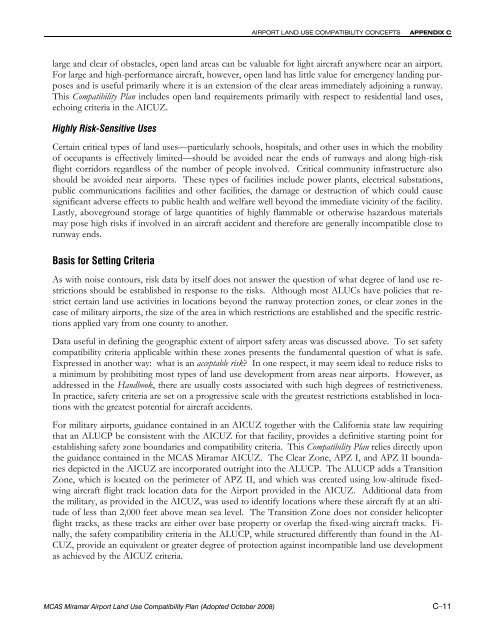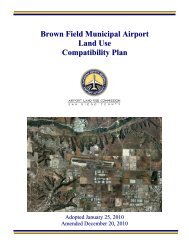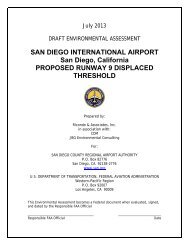MCAS Miramar Airport Land Use Compatibility Plan - San Diego ...
MCAS Miramar Airport Land Use Compatibility Plan - San Diego ...
MCAS Miramar Airport Land Use Compatibility Plan - San Diego ...
You also want an ePaper? Increase the reach of your titles
YUMPU automatically turns print PDFs into web optimized ePapers that Google loves.
AIRPORT LAND USE COMPATIBILITY CONCEPTSAPPENDIX Clarge and clear of obstacles, open land areas can be valuable for light aircraft anywhere near an airport.For large and high-performance aircraft, however, open land has little value for emergency landing purposesand is useful primarily where it is an extension of the clear areas immediately adjoining a runway.This <strong>Compatibility</strong> <strong>Plan</strong> includes open land requirements primarily with respect to residential land uses,echoing criteria in the AICUZ.Highly Risk-Sensitive <strong>Use</strong>sCertain critical types of land uses—particularly schools, hospitals, and other uses in which the mobilityof occupants is effectively limited—should be avoided near the ends of runways and along high-riskflight corridors regardless of the number of people involved. Critical community infrastructure alsoshould be avoided near airports. These types of facilities include power plants, electrical substations,public communications facilities and other facilities, the damage or destruction of which could causesignificant adverse effects to public health and welfare well beyond the immediate vicinity of the facility.Lastly, aboveground storage of large quantities of highly flammable or otherwise hazardous materialsmay pose high risks if involved in an aircraft accident and therefore are generally incompatible close torunway ends.Basis for Setting CriteriaAs with noise contours, risk data by itself does not answer the question of what degree of land use restrictionsshould be established in response to the risks. Although most ALUCs have policies that restrictcertain land use activities in locations beyond the runway protection zones, or clear zones in thecase of military airports, the size of the area in which restrictions are established and the specific restrictionsapplied vary from one county to another.Data useful in defining the geographic extent of airport safety areas was discussed above. To set safetycompatibility criteria applicable within these zones presents the fundamental question of what is safe.Expressed in another way: what is an acceptable risk? In one respect, it may seem ideal to reduce risks toa minimum by prohibiting most types of land use development from areas near airports. However, asaddressed in the Handbook, there are usually costs associated with such high degrees of restrictiveness.In practice, safety criteria are set on a progressive scale with the greatest restrictions established in locationswith the greatest potential for aircraft accidents.For military airports, guidance contained in an AICUZ together with the California state law requiringthat an ALUCP be consistent with the AICUZ for that facility, provides a definitive starting point forestablishing safety zone boundaries and compatibility criteria. This <strong>Compatibility</strong> <strong>Plan</strong> relies directly uponthe guidance contained in the <strong>MCAS</strong> <strong>Miramar</strong> AICUZ. The Clear Zone, APZ I, and APZ II boundariesdepicted in the AICUZ are incorporated outright into the ALUCP. The ALUCP adds a TransitionZone, which is located on the perimeter of APZ II, and which was created using low-altitude fixedwingaircraft flight track location data for the <strong>Airport</strong> provided in the AICUZ. Additional data fromthe military, as provided in the AICUZ, was used to identify locations where these aircraft fly at an altitudeof less than 2,000 feet above mean sea level. The Transition Zone does not consider helicopterflight tracks, as these tracks are either over base property or overlap the fixed-wing aircraft tracks. Finally,the safety compatibility criteria in the ALUCP, while structured differently than found in the AI-CUZ, provide an equivalent or greater degree of protection against incompatible land use developmentas achieved by the AICUZ criteria.<strong>MCAS</strong> <strong>Miramar</strong> <strong>Airport</strong> <strong>Land</strong> <strong>Use</strong> <strong>Compatibility</strong> <strong>Plan</strong> (Adopted October 2008) C–11
















